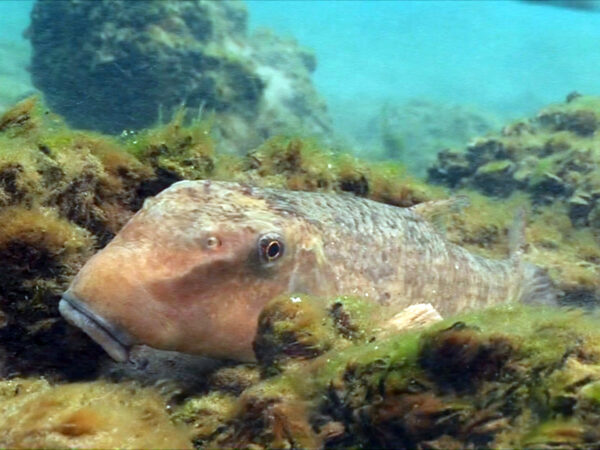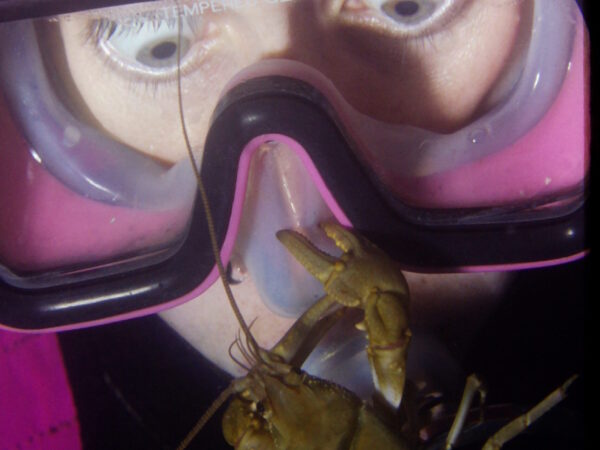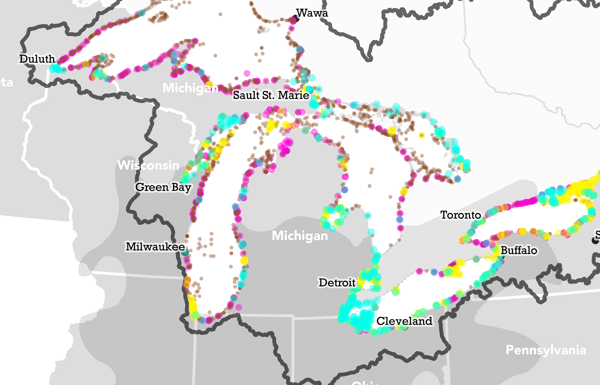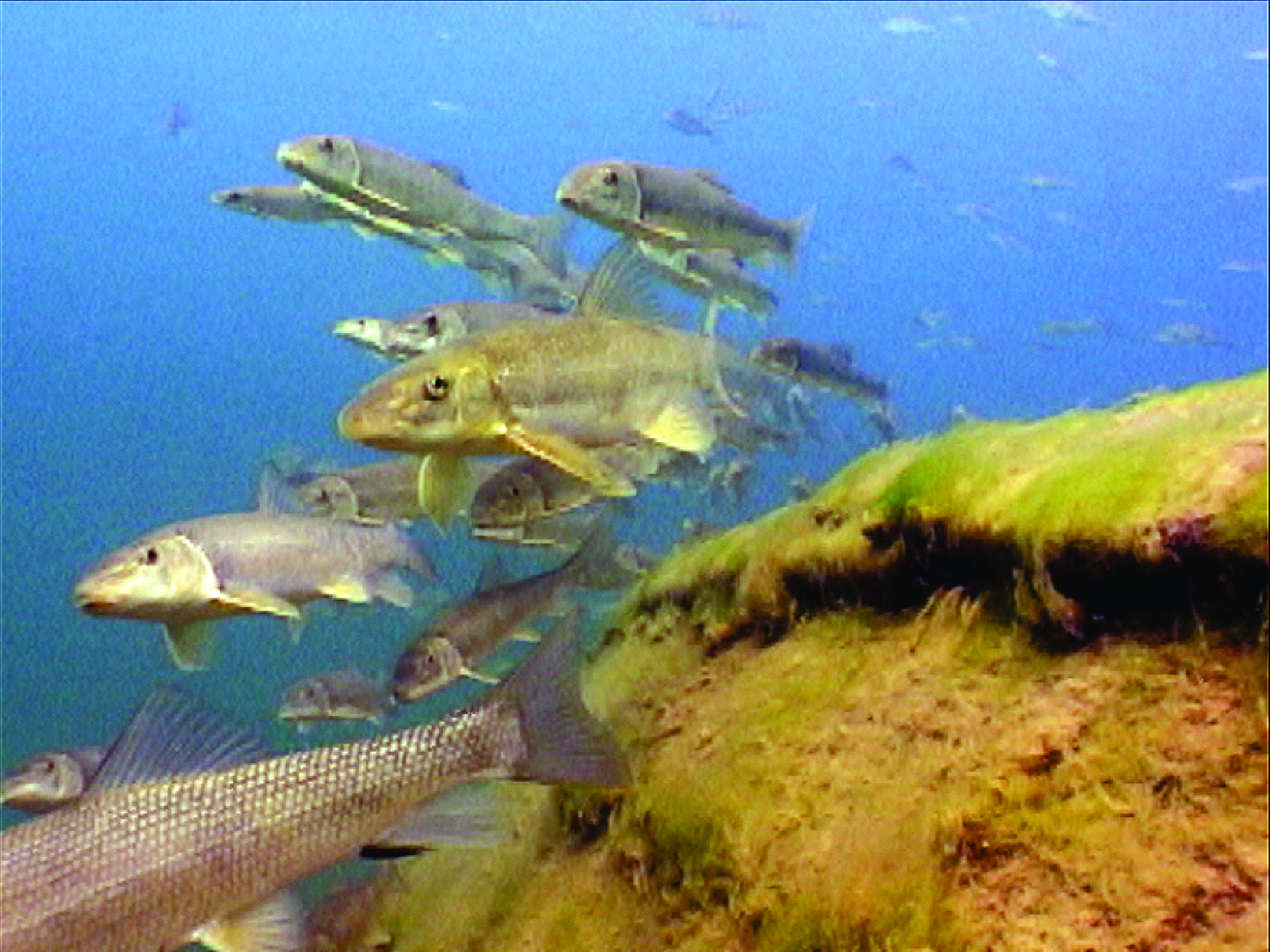
 I Speak for the Fish is a monthly column written by Great Lakes Now Contributor Kathy Johnson, coming out the third Monday of each month. Publishing the author’s views and assertions does not represent endorsement by Great Lakes Now or Detroit Public Television. Check out her previous columns.
I Speak for the Fish is a monthly column written by Great Lakes Now Contributor Kathy Johnson, coming out the third Monday of each month. Publishing the author’s views and assertions does not represent endorsement by Great Lakes Now or Detroit Public Television. Check out her previous columns.
This column marks the two-year anniversary of I Speak for the Fish and I feel deeply indebted to you, the readers, as I only get to write these if you continue to read and share them.
So, thank you.
With 24 pieces already published, some may be wondering if the freshwater story well is running dry. Not to worry, there are still dozens and dozens of aquatic and semi-aquatic species yet to highlight.
For this month’s column, I decided to do a top 10 style piece. My challenge was determining what to use as criteria for creating the list.
Should I rank the columns by page views? Use the most views, comments and likes combined? Or go with my personal favorites which don’t always generate the most traffic?
I settled on a few of each.
The top three slots went to your favorites based on views, shares, likes and comments combined. I also included a few of my favorites and why each made the list.
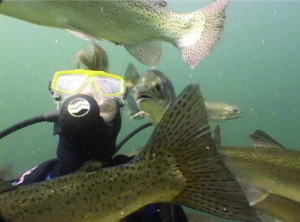
Trout Frenzy. (Photo Credit: Greg Lashbrook/PolkaDot Perch)
Reader’s Choice
It wasn’t even close.
The winning column had more than twice the number of views and twenty times the comments as second place. When it comes to freshwater fish — the muskellunge fanbase rules!
Following a reader’s suggestion, my January 2022 column was all about the mighty muskie.
In this column, I included the muskie world records for length and weight. I was confident my sources, the Royal Ontario Museum and the U.S. Fish and Wildlife Service, were sound and thankfully, they were in agreement.
The muskie fan base, however, did not agree. But then, as I was to discover, when it comes to records they don’t agree on much.
After six weeks of extensive research, including ordering used copies of old field guides to verify primary sources, I was able to confirm my sources and the muskie world records of 72.04 inches and 70.10 pounds.
While I have no objection to muskie devotees blowing up the Great Lakes Now website again, I have learned the importance of qualifying records. Specifically, the record for the largest specimen of any species of fish can come from a sport fisher’s pole, a commercial fisher’s net, a scientific survey or a carcass that washes up on a beach.
In this case, the longest and heaviest muskies on record were separate fish and neither was caught by a sportfisherman. I used this record because this column is about the fish themselves not fishing records.
I soon discovered that the record for the largest muskie caught by a sportfisherman is a quagmire of fishing tales that stretches over nearly a century of recordkeeping. I waded into the debate in a follow-up piece for Great Lakes Now.
That article held the number one spot for page views on the Great Lakes Now website for the majority of 2022.
This season we’re producing a piece for the Great Lakes Now monthly show spotlighting the Michigan Department of Natural Resource muskie rearing program. From the adult egg collections in a few weeks to releasing the juveniles this fall, stay tuned to our monthly show to see the full feature.
The second and third place columns were very close with only a few dozen page views separating them at 9,296 and 9,254 respectively. But the second place column about round goby in April of 2022 not only generated a few more views it also garnered the most likes of any column to date.
I think the popularity of the goby column was due, in part, to my offering a new perspective on a typically pigeonholed topic. Round gobies have been thoroughly villainized via thousands of articles, papers and even books that all reiterate the same negative impacts over and over.
Many remain resistant to the idea of using the word beneficial in conjunction with invasive species. But just because round gobies are typecast as villains doesn’t mean they can’t play other roles.
Third place was also on my personal shortlist. The August 2022 column about gizzard shad includes one of my favorite dive stories. It contains all the components of a great tale.
A life-threatening crisis. A dramatic rescue. And a happy ending.

Gizzard Shad. (Photo Credit: Greg Lashbrook/PolkaDot Perch)
Author’s Pick
Like any good parent, I hate to admit to having favorites, even if I do. But I honestly do not have a favorite column.
While I might favor one of the openings over the others or the way I played with a cliché in another piece, after a decent amount of time perusing all the columns, I failed to assign any rankings.
Since selecting a top three by personal preference wasn’t working, I tried another approach. I picked some of my favorite memories from diving in the Great Lakes and the columns that include those moments – in no particular order.
The July 2022 column features one of my favorite freshwater fish behaviors to watch. Male rainbow darters during their spawn are one of the most beautiful sights to see underwater in the Great Lakes.
When it is time to spawn the largest male gets the girl.
And, just to keep everyone honest, the males literally press their tails together and measure up. But what happens if they are the exact same size? Well, for one, it makes for a top ten dive.
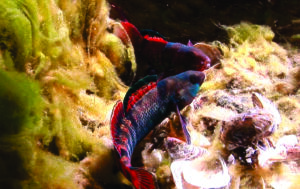
Rainbow Darter. (Photo Credit: Greg Lashbrook/PolkaDot Perch)
I may not have a favorite column but there is one dive that always comes to mind when I close my eyes and picture myself underwater. I’m surrounded by the largest, most aggressive school of rainbow trout I’ve ever encountered.
It is hard to describe the energy and excitement of being inside an actual fish feeding frenzy but I gave it a try in my May 2022 column.
I’m not alone in my adoration of catfish. The September 2021 column about catfish had the fourth highest number of views and the second highest number of likes.
I’ve held madtoms in my palm, admired the velveteen sheen of channel cats and been mesmerized by schools of tiny bullheads and no matter the size or species, cats are always cool to see.
In addition to some fascinating facts about catfish, No Petting for These Cats is also my favorite column title. Some writers and editors are brilliant at crafting the perfect title. I admire those folks.
While titles are not my Achilles’ heel; they are also not my forte. But I think this one is kinda purrfect.
Honorable mentions go to some of the underdogs. It’s telling that all the least viewed columns are about semi-aquatic species. Semi-aquatics are the species that spend part of their life underwater or, like me, as much time as possible in water.
I appreciate that reading a column entitled I Speak for the Fish one might expect it to be strictly about fish. But if you don’t know what a muskrat midden is or why mallards will not tolerate a diver below them, revisit these columns.
I hope you will find they are worth the read.
My goal for this column has always been to raise awareness for the diversity and abundance of life found in freshwater ecosystems. I plan to keep at it, including occasional shoutouts to semi-aquatics like salamanders who are as dependent on healthy freshwater systems as the rest of us.
Do you have a favorite I Speak for the Fish column? Make sure to hit the like button as every click is counted!
Please leave a comment below or share your favorite Great Lakes fish moment and let me know what species you would like to see spotlighted next.
Catch more news at Great Lakes Now:
I Speak for the Fish: Eyeballing Walleye
I Speak for the Fish: Playing follow-the-leader with diving ducks
Featured image: I Speak for the Fish 2 years. (Photo Credit: Greg Lashbrook/PolkaDot Perch)
1 Comment
-
How about a column on white perch. I didn’t know they existed until just recently?


